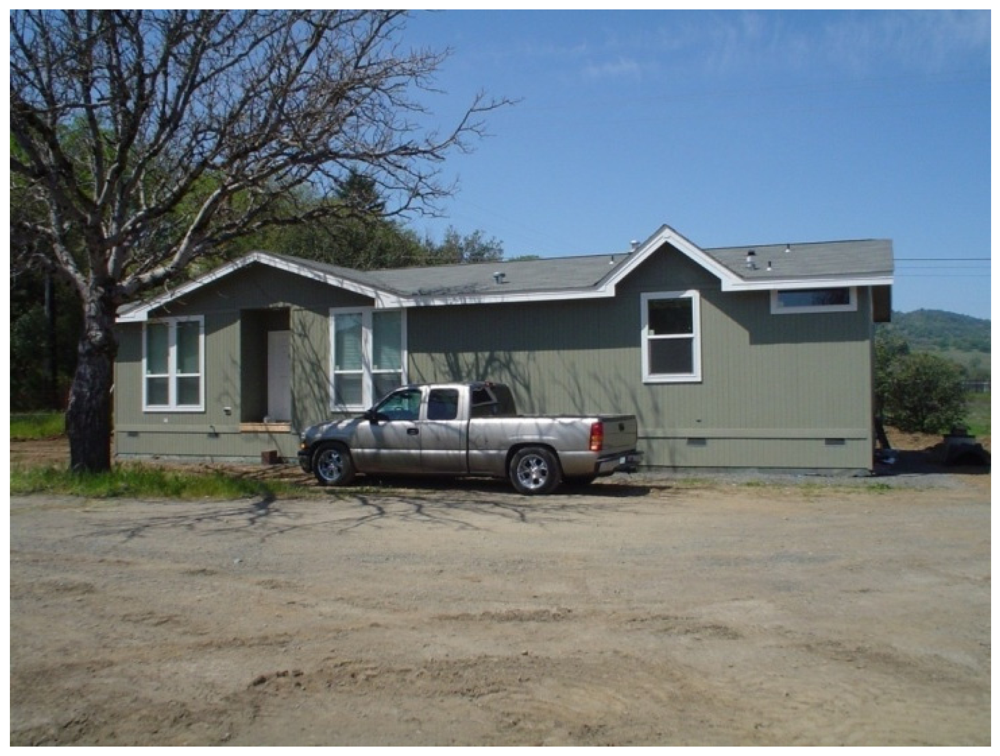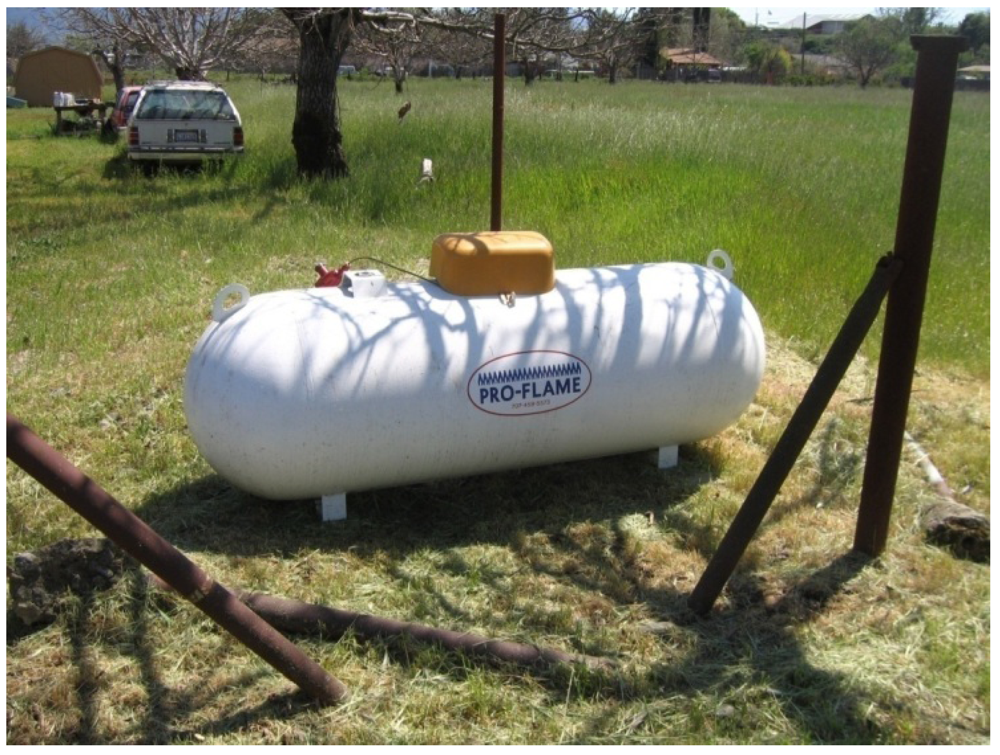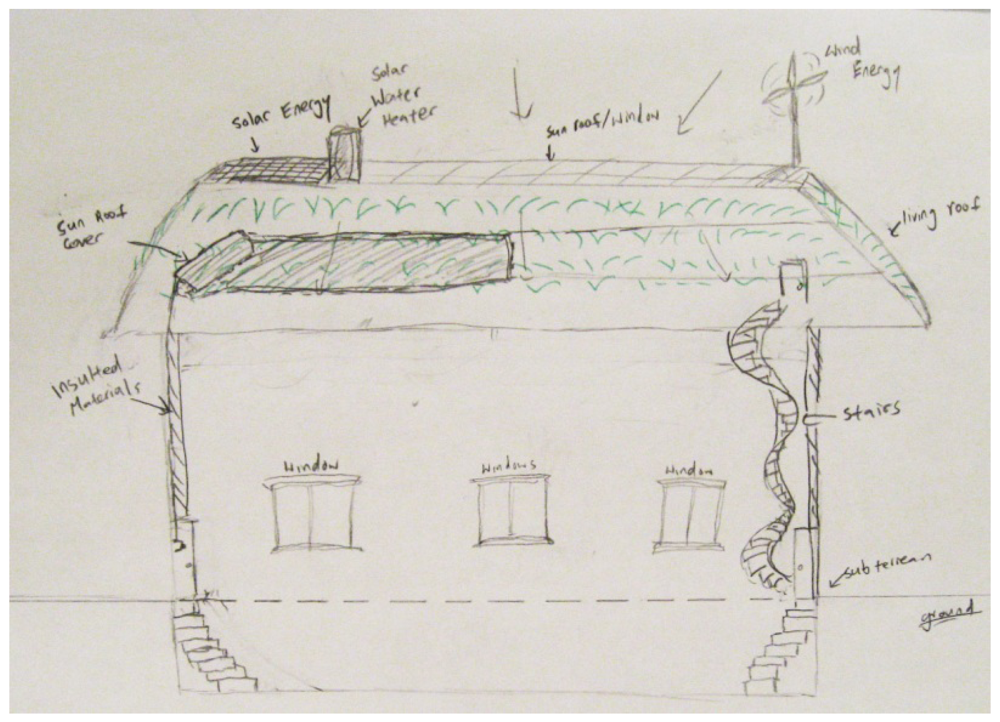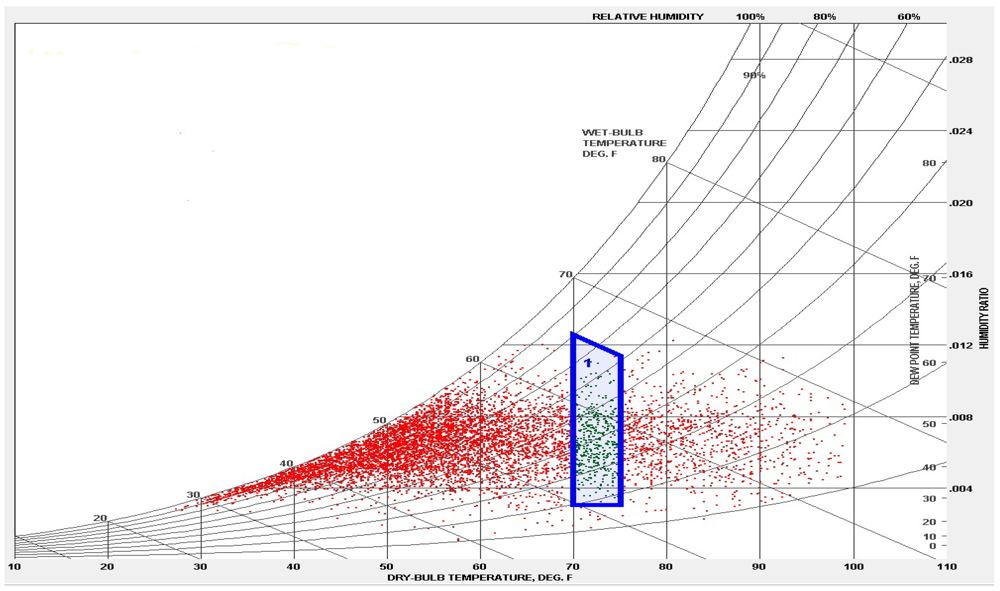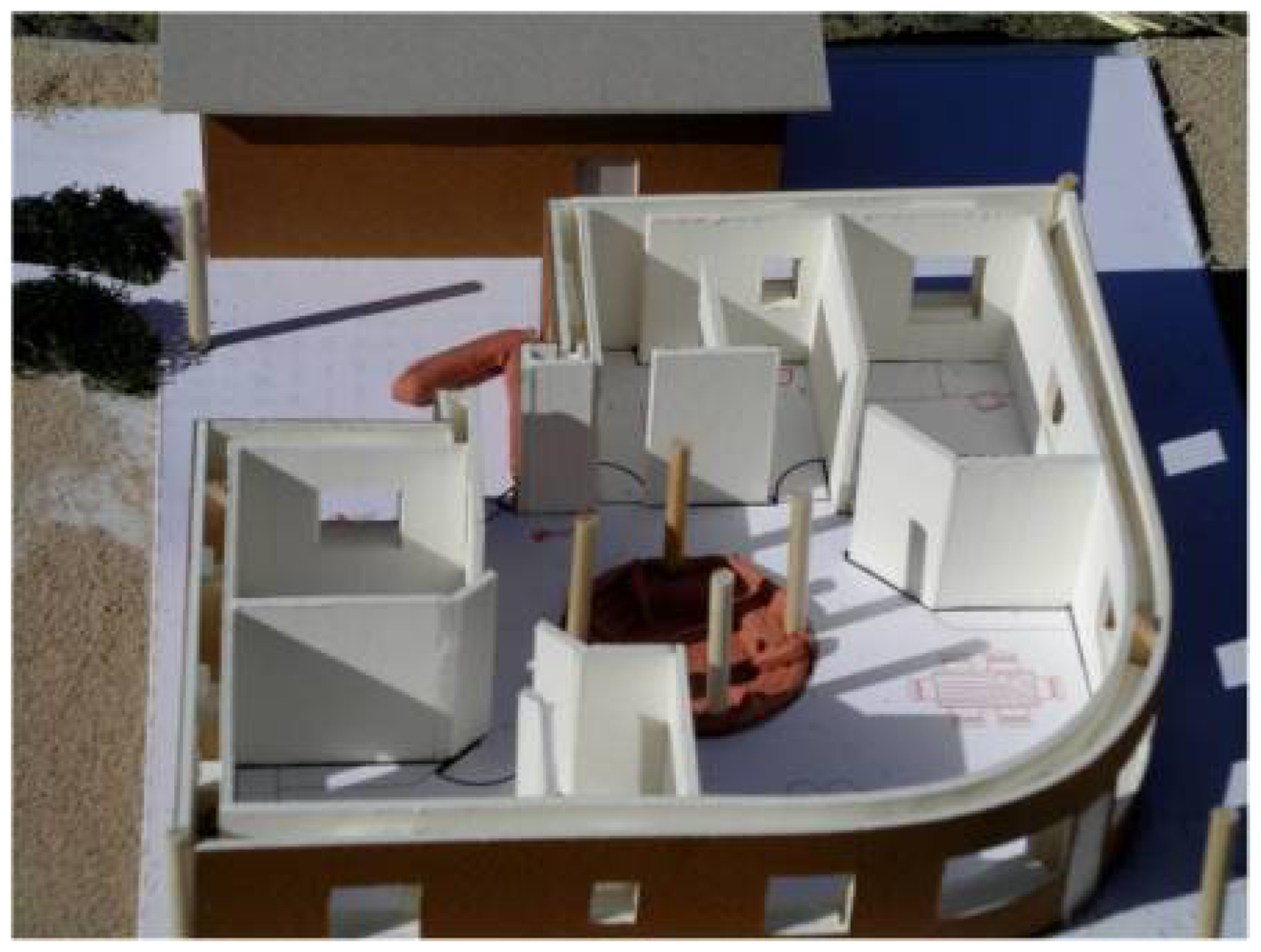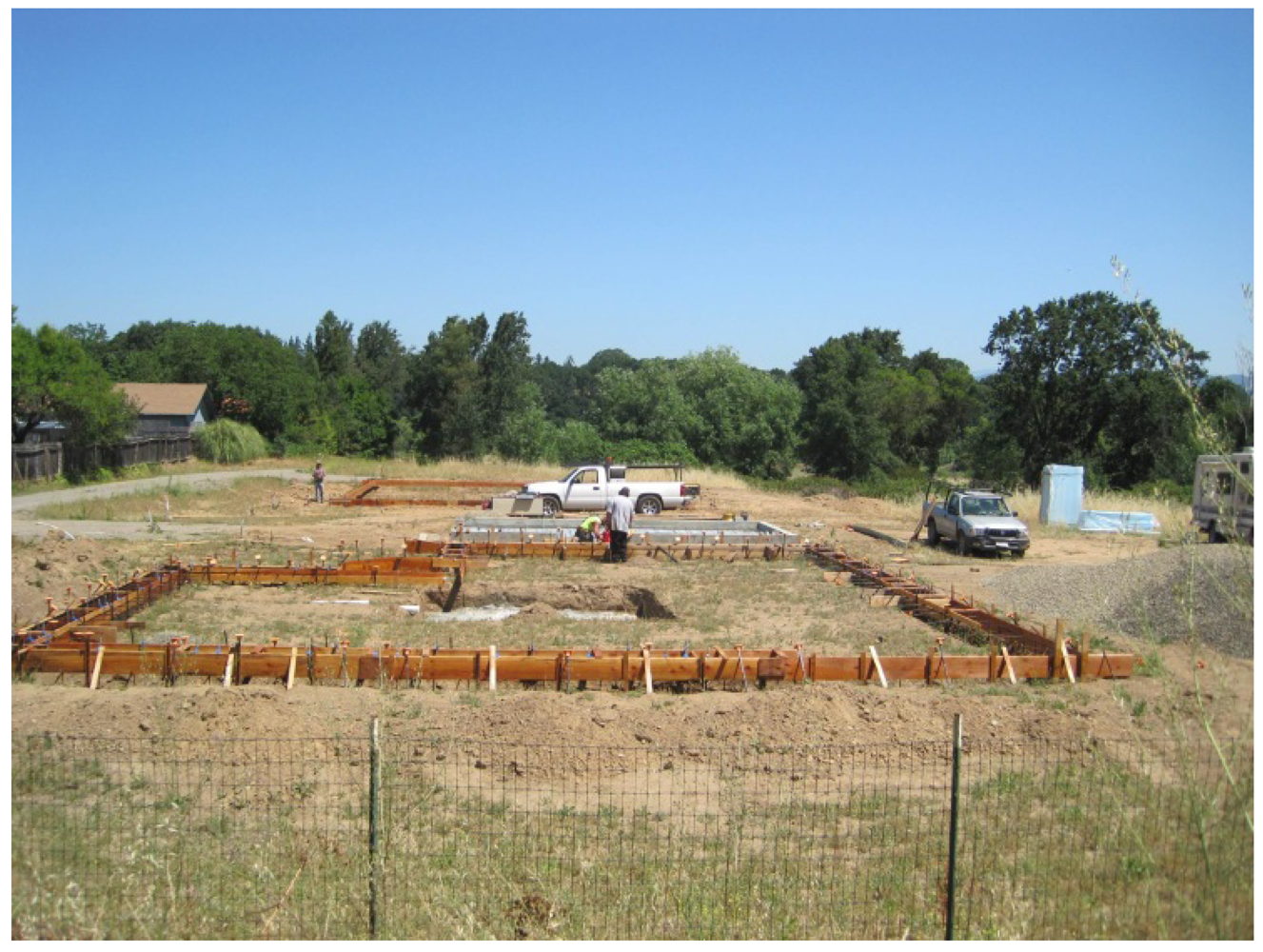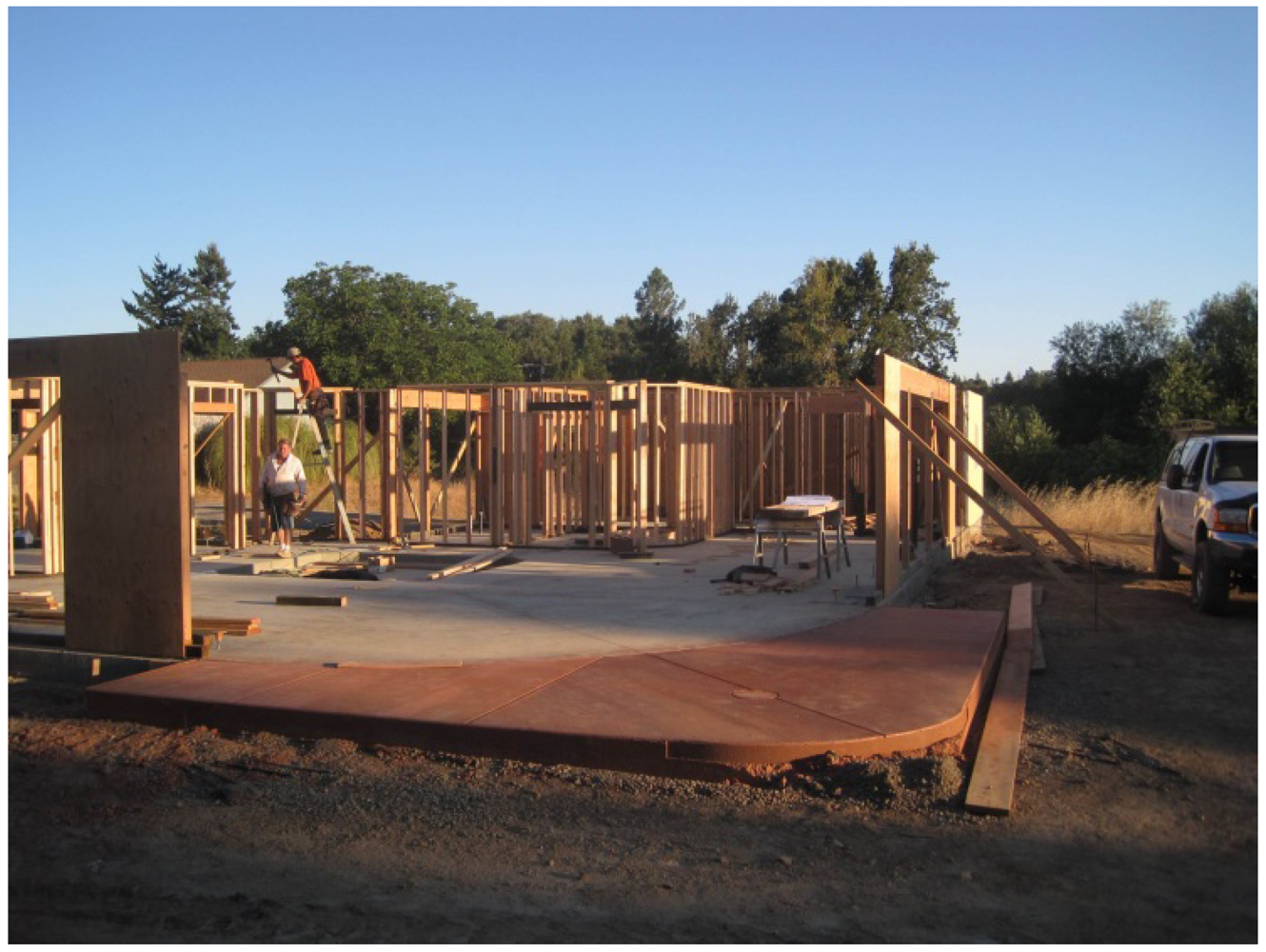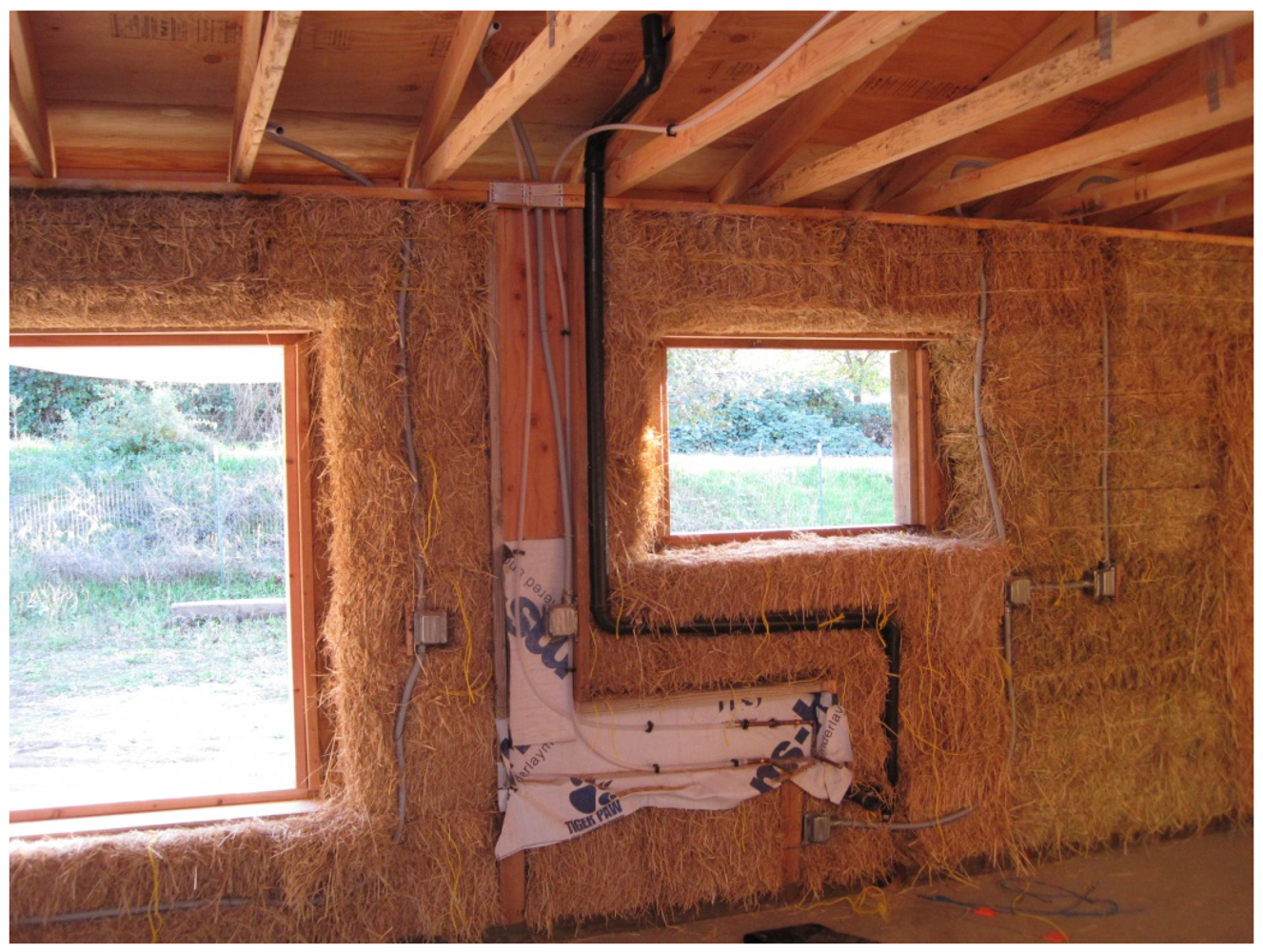1. Background: The Pinoleville Pomo Nation
The Pinoleville Pomo Nation (PPN) is a federally recognized, self-governing Native American tribe located in Northern California’s Mendocino County on the outskirts of the city of Ukiah; it is dedicated to ensuring that its “members enjoy safe, healthy, and environmentally benign environments, both natural and built” [
1]. The PPN traces its modern origins back to 1878 when a group of Potter Valley Pomos left the Round Valley Reservation due to lack of basic necessities and purchased 51 acres of land north of Ukiah. This land was called ke-buk ke-bul, but was soon known as Pinoleville. Unfortunately, the citizens of Ukiah expressed extreme dissatisfaction of Pinoleville residents’ ceremonial cremation and loud wailing practices that sometimes last for several days after a death occurred. In 1893, the 51 acres of land were traded for 100 acres between Ackerman Creek (as known as ya-mo bida in Pomo or wind hole creek in English) and Orr Springs Road by the Pinoleville captains and other Northern Pomo captains. In 1905, the Bureau of Indian Affairs (BIA) deemed the privately owned land overcrowded and utilized a series of Congressional appropriations to acquire additional lands for the families of Pinoleville. This land acquisition was originally known as the Ukiah Rancheria. Later on, it became known as Pinoleville Rancheria [
2].
The passage of the Indian Reorganization Act (IRA) in 1934 was aimed at increasing Native American self-governance and resulted in the reorganization of some tribal governments, such as Pinoleville, with a written constitution to manage their internal affairs [
3]. However, efforts soon began in the 1940s to shift the federal policy of self-governance for Indian tribes to a termination policy of tribes as sovereign nations in order to force tribal peoples to assimilate into the general populous. In 1958, these efforts came to fruition when the U.S. Congress passed the California Rancheria Termination Act in which the federal government absolved its responsibility for managing or financially supporting between 40 and 44 California Rancherias by transferring land ownership directly to respective tribes and not completing agreed upon federal economic, housing and water infrastructure development endeavors within California Rancherias [
4].
In 1966, the Pinoleville Rancheria was terminated and the land deeded to individuals known as allottees. In 1983, Pinoleville was a part of a class action suit called Tillie Hardwick v. USA that won federal recognition for 17 terminated tribes [
5]. Pinoleville completed its reorganization on June 26, 2005 when a constitution was approved. A council of seven elected members now governs the tribe of roughly 250 citizens.
2. Background: Tribal Governments and Sustainability
Native American tribal governments throughout the United States of America have placed great importance upon achieving environmental harmony within their lands. These tribal governments have begun to discuss ways to reduce their tribe’s environmental impacts and improve their overall personal level of sustainability. Examples of Native American tribal governments pursuing sustainability endeavors include the Campo Band of Mission Indians of the Kumeyaay Nation 50 MW wind energy facility, Council of Athabascan Tribal Governments (CATG)-Fort Yukon wood energy program, Scotts Valley Band of Pomo Indians’ Tribal Multi-County Weatherization Program in Northern California, and the Elk Valley Rancheria energy efficiency projects [
6,
7,
8,
9]. Ambler (1990) [
10], Nadasdy (2003) [
11] and Smith (2010) [
12] point out in their works that Native American nations have an extensive history of implementing sustainability and environmental endeavors with and without help from non-Native members and organizations. In particular, Nadasdy documents the difficulties that the Kluane First Nation in Canada encountered in terms of getting their local knowledge and solutions to their environmental issues accepted and utilized by Canadians officials. Nadasdy conjectures that the devaluing of the Kluane First Nation’s local knowledge is a mere expression of power that is utilized by paternalistic governments and academic institutions to continue to exert control and influence over the Native people in affairs ranging from sustainability endeavors to energy development to education.
It should be noted that Native American tribes that are considered to be “federally recognized tribes” or sovereign nations by the United States government have the right to create memorandums of understanding and have a direct government-to-government relationship with the U.S. government and other local governments. Currently, the Bureau of Indian Affairs (BIA) has granted 565 Native American tribes status as “federally recognized tribes” [
13]. Unfortunately, the interactions amongst Native American communities, the United States government, and academic communities have not been the most pleasant. Historically, federal laws concerning Native Americans have hindered the ability of Native American tribes to increase their economic and community stability. The initial U.S. Native American laws were based on the doctrine of discovery, which established a legal relationship between European discoverers and the Native American tribes [
12,
14,
15]. This doctrine gave ownership of native lands in the hands of the "discoverers", but allowed the Native Americans to continue to live on the lands. As a result, tribal governments are rather suspicious about federal officials and have a reduced willingness to partner with federal agencies and non-tribal members for fear of not being treated as equal partners.
These partnerships failed due to the fact that a technology driven approach is taken to meet the sovereignty, economic self-sufficiency, and environmental goals of the tribal governments. In this technology driven approach, emphasis is placed on getting the information of the target end user group in order to stay within budgets, fulfill federal policies, and/or meet publication deadlines. Little or no time is spent on understanding the needs of the Native American communities and building trust. However, there are recent examples of successful partnership between tribal governments and non-tribal organizations as it related to the development of appropriate environmental management solutions.
The Navajo Nation Council, for example, has developed a policy “to promote harmony and balance between the natural environment and people of the Navajo Nation, and to restore that harmony and balance as necessary” [
16]. To implement this policy, the Navajo Tribal Utility Authority (NTUA) has been pursuing renewable energy power generation from wind power to provide electricity to 18,000 Navajo homes that currently are not electrified [
17]. These homes account for approximately 75% of tribal homes in the United States that have not been electrified [
17]. The Navajo Nation has also cultivated a partnership with Sandia National Laboratories and the Environmental Protection Agency to address the issues of water and soil contamination by uranium mining that occurred during the 1940s through the 1980s [
18,
19,
20].
The roughly 4 million tons of uranium extracted from the 27,000 square mile Navajo Nation provided critically needed material to the United States nuclear weapons program, but left a number of physical structures and water sources contaminated with radiological materials and waste that have been shown to cause chronic respiratory symptoms and act as a reproductive toxicant [
21,
22]. In order to address this issue, engineers and scientists from Sandia National Laboratories went into several Navajo communities and met with the people in order to determine which technologies were culturally appropriate and could be transferred to the Navajo Nation to clean up the communities exposed to contamination by uranium and processing chemicals. The Navajo Nation was able to take the lead in defining the scope of the projects and prioritizing the objectives of the projects. This partnership has lead to an improvement of the health of the members of the Navajo Nation and also has led to increased discussions about developing the renewable energy potential of the Navajo Nation’s lands. However, 520 abandoned uranium mines still dot the lands of the Navajo Nation and there are concerns that the federal cleanup efforts are stalling due to funding and lack of urgency by government officials [
23].
3. Related Work: Meanings of Sustainability
Since the creation of the term ‘sustainable development’ in the Brundtland Commission’s report in 1987 until the present, there has not been a determinate meaning assigned to it. Over the last 25 years, advocates of the term have been trying to assign different framings to the ill-defined concept first expressed in the report: that development should “meet the needs of the present, without compromising the ability of future generations to meet their own needs” [
24]. However, the modern discourse in this arena has glossed over or taken for granted the assumptions and conclusions that underline ‘sustainable development’ [
25]. If one reviews the ‘sustainable development’ concept presented in 1987, one finds that ‘needs’ are not defined, the processes for meeting these ‘needs’ are not defined, and that there is an implicit assumption that the society of the present will understand the needs that the society of the future will possess. It is unknown why the Brundtland Commission did not lay specific ‘needs’ of the present and future and specific processes for meeting such ‘needs’. One can theorize that perhaps the Brundtland Commission understood that ‘needs’ are unique to each society or end user group and that one could not make a blanket list of specific ‘needs’ that covers all of humanity.
Even if this theory is true, this still does not explain why the Brundtland Commission thought that modern society can predict the ‘needs’ and priorities of future societies. Despite this ambiguity, modern attempts are still made to bring some sort of unifying meaning to the concept of ‘sustainable development’ in order to apply this concept freely in fields ranging from mechanical engineering, to environmental policy, and to economic policy without a firm understanding of the underlying ‘sustainable development’ foundation. These modern attempts to frame sustainability typically involve a Venn diagram that shows an interrelation amongst (1) people, (2) planet, and (3) prosperity or as (1) environment, (2) economics, and (3) society (See
Figure 1). Farrell and Hart (1998) define these frameworks as having competing objectives that try to balance meeting a broad range of targets [
26]. However, the explanation behind these frameworks is unclear. Are the distinct objects in Venn diagrams the ‘needs’ that the Brundtland Commission refers to or are they just indicators that can be used to measure compliance to a set of ‘needs’? If so, which society do these ‘needs’ relate to?
Figure 1.
Modern Frameworks for Sustainability.
Figure 1.
Modern Frameworks for Sustainability.
The current discourses in this arena do not explain how these frameworks were created, the relationships, and the priorities that these frameworks have with humanity. Instead, it is implied that these two frameworks are related to the whole of humanity because the frameworks focus on general concepts that affect and/or are important to humanity. Moreover, the supporters of the concepts of ‘sustainability’ and ‘sustainable development’ debate what roles and primacy, if any, does policy, people, the environment, and economics play in advancing these concepts. For some supporters (sustainability consequentialists as we denote them), the environment is merely a means to the end of providing resources that maintain and/or improve the quality/goodness of life for society. Using this line of reasoning, societal, political, and economic principals should be designed in such a way to maximize a people’s benefit (typically monetary benefit) from said environment. The term environment (and it boundaries) though is still a vaguely defined concept for now. This view of the environment, however it is defined, does not necessarily mean the environment has to be safeguarded from pollution or harm at all as long as roads, transmissions lines, and other goods are created as compensation so that others can benefit. This concept is also known as weak sustainability (WS) [
27,
28]. If the protection of the environment from harm is an additional consequence of allowing a society to benefit from the environment, then so be it.
For example, the extraction of oil from Canada’s Athabasca tar sands utilizes an open mining technique that involves removing portions of the boreal forest. Society A’s decision to remove sections of the boreal forest environment does not violate the sustainability consequentialist’s viewpoint as long as Society B is not prohibited or hindered from performing the open mining technique and using the roads in the same sections of the boreal forest environment for its benefit. However, the actions of Society A could prohibit Society C from using the boreal forest environment and its boundaries for other activities besides the extraction of oil. So, how does one balance the desires of this other society to utilize the environment and its boundaries for its own purposes and benefits? Shouldn’t a society place importance on preserving the environment first? After all, if the environment is destroyed or harmed, a society would be hard pressed to maintain its quality of life. Supporters of this viewpoint (let’s call them environmental primalists) believe that the environment should have primacy over political, economic, and societal goals. Therefore, the goals and principals of policy, economics, and society should be geared towards protecting the environment and its boundaries from harm and pollution first and then one should seek means to maintain and/or improve the quality of life for society without violating the primacy of the environment. This concept is also known as strong sustainability (SS) [
27].
If we reconsider the same example of extracting oil from Canada’s Athabasca tar sands, the environmental primalists’ view would lead to the conclusion that Society A’s actions would be prohibited since it damages or harms the boreal forest environment due to the removal of trees and the consumption of water from the Athabasca River. As a result, Society A would have to find another means to extract the oil that does not do damage to the environment. Cultural primalists, on the other hand, would place importance upon meeting and maintaining the knowledge base, belief system, and/or behavior of society first and then resources would be geared towards preserving the environment and upholding political and economic principals. From the cultural primalists viewpoint, the extraction of oil from tar sands via open mining may not be in violation as long as this action does not hinder a society’s ability to keep utilizing its knowledge base, belief system, and normal behavior. We present three varying viewpoints of ‘sustainability’ and ‘sustainable development’: sustainability consequentialists, environmental primalists, and cultural primalists. A universal definition of ‘sustainability’ and ‘sustainable development’ does not exist yet due to the large variability in how one can define these two terms. In order to overcome these epistemological issues, one must, as Redclift [
25] and Jamieson [
27] suggest, define or situate ‘sustainability’ and ‘sustainable development’ in the local context of the community or society that is trying to address the two concepts. This begs the question of which methodological framework or design process should be utilized to situate these concepts in the local context of a community such as the Pinoleville Pomo Nation.
4. Related Work: New Product Development Methodologies
New Product Development (NPD) describes the process in which a designer creates a product, service, and/or system and introduces it to the market for adoption and usage by an end user group [
29]. It should be noted that in this paper, a distinction is made amongst designer, end user, and consumer. A designer is considered to be a person that makes preliminary plans, products, and/or services that have not been adopted and utilized by an end user, while an end user is a person that actually uses the product, service, and/or system created by the designer. The customer is the person that purchases or exchanges goods in order to obtain the product, service, and/or system created by the designer. The customer and the end user are not necessarily the same person. For example, a mother, the customer, may purchase a toy for her child, the end user.
Furthermore, needs are defined as the subjective requirements that a customer or the end user has for a product, service, and/or system. These subjective requirements or metrics from the user can be vague and do not need to be exact specifications for a product function [
29]. For example, an end user might express a need for a lawnmower that is “easy to use”; however, the production specification for that need might be a lawnmower that only requires “2 Newtons to move the lawnmower a distance of 3 ft in less than 120 seconds”.
The end goal of NPD is to create products, services and/or systems that the end user will adopt and use. The NPD process typically involves seven stages: (1) Opportunity Recognition, (2) Idea Creation, (3) Idea Selection, (4) Idea Development, (5) Idea Testing, (6) Idea Implementation, and (7) Idea Expansion & Adoption.
Figure 2 provides a graphical representation of the NPD process [
29].
Figure 2.
Overview of the New Product Development Process.
Figure 2.
Overview of the New Product Development Process.
In New Product Development (NPD), there are two methodologies that are typically utilized: Technology-Driven Design (TDD) and Human-Centered Design (HCD). The TDD methodology advocates for the development of new products, services, and systems based upon the designers/company’s technical abilities/core competencies instead of customer demands and end user needs. As a result, importance is placed upon designing products around the objectives of (1) time to market (reducing time need to introduce the product to the consumer), (2) price points (determining the price at which consumers will buy the product), (3) manufacturability (determining how fast the product can be built and mass produced), (4) performance (determining what standards the product has to adhere to), and (5) reliability (determining the life span or usefulness of the product). After it is determined that the product, a piece of technology such as a compact fluorescent lamp (CFL) for example, has been designed to meet the above mentioned objectives of its designers, attention is then given to determining how to modify it so that the targeted consumer and end user groups will adopt and utilize the product.
In contrast, the central tenet of the Human-Centered Design (HCD) methodology is that design should be driven by human needs, with no prior assumptions about solutions or technologies to be applied [
30]. As a result, importance is placed upon determining how to design products to meet the needs of the end user instead of determining how to market technologically-driven products to end users. In order to elicit needs from end users, the HCD methodology typically employs qualitative research tools such as customer focus groups and interviews [
31,
32]. After conducting a series of focus groups and one-on-one interviews about office equipment design, Griffin and Hauser (1993) determined that there is no ‘best’ method for eliciting needs and that both interviews and focus groups are valid approaches [
33], but interviews may be more cost-effective.
5. Methodology: Co-Design Methodology
The Co-Design (CoD) methodology, as presented by the authors [
34], has similar aspects to HCD and its associated qualitative research tools in that both methodologies place a high value on understanding the needs of the end users and gathering feedback from the end users and stakeholders throughout the design process. The central tenet of CoD, however, is to create products that meet the full range of consumer requirements/needs while maximizing profits by giving both the end user and the designer shared control during the NPD process. In CoD, the end user has expertise about their needs and determines whether or not a product is appropriate for their needs and environment. Both the end user and designers are given agency throughout all stages of the NPD and are allowed to design products that are embedded with the needs of the end user.
The Co-Design methodology has three stages: (1) Trust Building, (2) Split Group User Needs Assessment & Prioritization, and (3) Brainstorming on Conceptual Designs. The underlining principal of CoD is that the residents of the community, the PPN in this case study, are considered to be experts on their needs and therefore should co-design solutions with designers and engineers throughout the NPD process to meet their needs. The voice and point of view of the user community is at the forefront throughout the entire NPD process. The authors have found that CoD is effective at creating a sense of trust between Native American communities that have been historically traumatized when it comes to working with outsiders because the Co-Design workshops create an environment where tribal members not only express their needs, but also actively utilize their local knowledge to co-design solutions to meet those needs. In terms of creating participatory workshops and methodologies, Street (1987) [
35] and Fraser
et al. (2006) [
36] found that community members involved in workshops gained a better understanding of the concerns across their community. Moreover, the community participants felt that they were more empowered to actively address the concerns facing their community when a larger and more complete list of indicators for environment impact assessment (EIA) were generated by both community members and experts in participatory workshops.
6. Pinoleville Pomo Nation Case Study
The Pinoleville Pomo Nation (PPN) has several members scattered throughout Northern California, and many of these members are seeking to return to their ancestral lands and traditional community. In order to meet the growing demand of people seeking to return to the lands of the PPN, the PPN has undertaken two land purchasing and housing development ventures. Some of the PPN’s concerns are related to rising heating (
Figure 3) and cooling costs associated with the current houses funded by the U.S. Department of Housing and Urban Development (HUD) [
37]. For most of the PPN’s homes, firewood and natural gas are utilized as the primary sources of space heating. Moreover, the current homes provide basic necessities but no representation of the cultural and traditional values of the PPN.
Figure 4 and
Figure 5 show example prefabrication homes and natural gas systems utilized by members of the PPN. As a result, the PPN sought to implement sustainable technologies and best practices that will increase their self-sufficiency and meet their housing, energy, and water conservation needs. It should be noted that the PPN, however, neither had the in-house technical expertise, nor adequate funding, to develop and implement the thorough designs they aspired to. In the March 2008, the PPN contacted UC Berkeley and the Community Assessment of Renewable Energy and Sustainability (CARES) project in the hope of creating a partnership that would help them achieve their goals [
38].
On April 13, 2008, 40 residents of the PPN in northern California, 14 participants from the University of California, Berkeley (UCB) and CARES utilized the Co-Design methodology to understand the sustainability and environmental needs of the PPN community in order to provide recommendations for housing designs for the community. The innovation workshop began with an ice-breaker session in small groups of 3–5 people. The listening session was then followed by a large group round robin session on good and bad technologies in order to increase the comfort level of discussing technology and to learn the impact of different technologies on different members of the community. In order to increase the comfort level of all the participants, no titles were used during the innovation workshop. Next, the participants were divided into three groups (Elders, Adults, and Youth) and the participants described and/or illustrated specific needs related to sustainability in their current environment (
Table 1).
Figure 3.
California Natural Gas Residential Prices.
Figure 3.
California Natural Gas Residential Prices.
Figure 4.
Prefabrication Homes Utilized by Pinoleville Pomo Nation (PPN) Residents.
Figure 4.
Prefabrication Homes Utilized by Pinoleville Pomo Nation (PPN) Residents.
Figure 5.
Natural Gas System Utilized by PPN Residents.
Figure 5.
Natural Gas System Utilized by PPN Residents.
Table 1.
Needs Expressed During Split Group User Needs Assessment Sessions.
Table 1.
Needs Expressed During Split Group User Needs Assessment Sessions.
| Split Group Needs Assessments |
|---|
| Elders Group | Adults Group | Youth Group |
|---|
| Work | Privacy in homes | Cooling | Hunting |
| Exercise | Activity space (sleeping, playing) | Heating | Lighting |
| Fresh air | Lower electricity bills | Privacy | Fun |
| Less overcrowding | Clean road (no dirt when dry/mud in rain) | Sleeping | Individuality |
| Host visitors for extended time | Larger cooking space | Swimming | Eating |
| Accessibility for disabled | Larger working area | Space and storage | Surviving |
| Build crafts and designs | Openness in homes | Driving | Convenient |
| Grow one’s own foods and traditional herbs | Protection from strangers | Comfort | Power generation |
| Places to socialize within community (unplanned and planned) | Privacy between homes | Safety | Shelter |
| Want youth to get excited about hands-on activities | Protection from animals | Showering | Community |
| Learn and use traditional building techniques | Storage Space | Exercise | Happiness |
| Buy equipment to teach youth new skills | | Personal connection | Transportation |
| Traditional Pomo housing: Circular | | Attractiveness | Cultural integration |
The participants then voted on the top needs identified by the three groups using Post-it notes and markers (
Table 2)—multivoting. Finally, the participants were divided into five mixed-age groups on the topics that got the largest number of votes (Traditional Building Techniques, Energy Generation and Conservation, Exercise and Recreation, Privacy, and Heating, Cooling, and Lighting) to brainstorm on conceptual design solutions based on the needs generated by the Elders, Adults, and Youth group.
Figure 6,
Figure 7,
Figure 8 show images and concepts from the first innovation workshop.
Table 2.
Prioritized List of Needs (number of votes).
Table 2.
Prioritized List of Needs (number of votes).
| Top Needs From All the Groups |
|---|
| Privacy (10) |
| Storage (9) |
| Safety (9) |
| Comfort (5) |
| Exercise (5) |
| Conserve Energy (5) |
| Lower Energy Costs (4) |
| Learn and Use Traditional Techniques (4) |
| Space (4) |
Figure 6.
Solar and Wind Power Generation Concept.
Figure 6.
Solar and Wind Power Generation Concept.
Figure 7.
Wind Power Generation and Grey Water Concept.
Figure 7.
Wind Power Generation and Grey Water Concept.
Figure 8.
Wind Power Generation and Human Power Concept.
Figure 8.
Wind Power Generation and Human Power Concept.
7. Climate Characteristics and Strategies
After the co-design workshop, an analysis of climatic features of the Pinoleville Pomo Nation land reserve was performed and building strategies were undertaken to refine the co-designed housing prototypes. The California Energy Commission established 16 climate zones to represent geographic areas in California. Ukiah is located in Mendocino County and is situated in California Climate Zone 2. This climate is characterized by cold winters and hot summers with a very small number of days within the comfort zone (75–100 °F).
Figure 9 is a psychrometric map of California Climate Zone 2 [
39]. This chart, produced by “Climate Consultant 5.3”, a software developed at UCLA [
40], shows the temperature and humidity for every hour during a full year. The trapezoidal area (highlighted in blue) marked as #1 represents the comfort zone and includes, in this area, only 5.1% of the time.
During 12% of the time, the temperature range is above the comfort zone (75–100 °F) while during most of the time (81%) the temperature is too cold, ranging between 32–70 °F and only rarely getting even cooler than that. This means that this climate suffers both from cold and hot weather and will need solutions for both situations to make temperatures more comfortable. During the winter months the climate is usually too cold, while during the summer months, temperature ranges from being very hot during the day to too cold during the night (
Figure 10). The low range of humidity during the summer months makes the heat easier to overcome with passive cooling solutions; buildings with high thermal mass will reduce the heat load and will add 20.2% of the hours into the comfort zone (marked #3 in
Figure 10). The addition of night ventilation to this strategy will help quickly cool down the thermal mass, adding 3.3% more hours into the comfort zone (marked as area #4 in
Figure 10).
Figure 9.
Full Year Psychrometric Map of California Climate Zone 2.
Figure 9.
Full Year Psychrometric Map of California Climate Zone 2.
Figure 10.
November through March—Psychometric Map of California Climate Zone 2 in Winter.
Figure 10.
November through March—Psychometric Map of California Climate Zone 2 in Winter.
These two strategies will take care of nearly all of the over-heated hours and can completely eliminate the need for active cooling systems like air conditioning. The cold weather is more difficult to overcome in this climate as it is spread throughout the year, during both day and night time. Nevertheless, adding direct internal heat gain through southern windows (marked as #9 in
Figure 11) as well as passive direct solar gain through high mass (e.g., heavy wall absorbing direct radiation and radiating it back as heat into the house) can cover 32% more of the cold hours through the year. These potential strategies bring us to a total of 68% of the time which will not require active, energy-consuming solutions for gaining thermal comfort at home. The rest of the time requires active heating strategies. However, an efficient heating strategy combined with well insulated walls and energy efficient technology can take care of this with minimum energy use.
Figure 11.
Potential of Design Strategies for Cool Weather.
Figure 11.
Potential of Design Strategies for Cool Weather.
8. Co-Designed Pomo-Inspired Housing Design
Based on the needs and the conceptual home designs co-generated from the innovation workshop and follow up interviews with members of the PPN, a new Pomo-inspired housing design shown in
Figure 12 was generated by undergraduate engineering students. A low fidelity prototype was used in order to elicit critical feedback and promote creative changes. The main structure of the design includes a large decagon with five hexagon shaped attachments and a dome shaped roof. They chose to incorporate one large circular central living space and then smaller add-on private spaces to address the dual needs of community living and openness, as well as address the need for more privacy.
This quick low-fidelity design concept also takes into account cultural and traditional respect for the four directions of North, South, West, and East in addition to Mother Earth (down) and Father Sky (up) for a total of six directions. It incorporates these philosophical ideas into the design by integrating five attachments and one main central unit, making six living spaces in total. Overall, the design aims to resonate with an historical yurt-like structure while also accommodating for the contemporary needs of larger families, including space for extended family visits. In the Pomo Indian culture, the elder family members will usually not move to nursing homes, rather they typically live with their children. Therefore, the design allows for “granny units” by using attachments for additional living space. The roof is dome shaped but flattens out at the top to increase available space for “living roofs”. The living roofs not only have insulating qualities, but also provide space for traditional plants to be grown (addresses needs of optimizing space, energy conservation, and cultural integration). The house includes a large number of windows to take advantage of natural light.
Figure 12.
Mockup of the Initial Prototype House for the PPN.
Figure 12.
Mockup of the Initial Prototype House for the PPN.
The second project of co-design between the PPN and UC Berkeley was a small neighborhood of 12–15 units on a newly acquired land of the PPN in Ukiah. The early process included a visit to the community and an initial “warm up exercise” to renovate a couple of existing housing. The exercise was intended to help the students become familiar with the current problems and advantages of HUD housing used by the PPN in several locations. It also provided benefits to the existing residents who could get design ideas for easy retrofits by working with the students. Dealing with a project, even in such a small scale, which involves real “clients” turned out to be more complex than initially thought. As before, the students needed to invest time in learning about the cultural aspects of Native Americans, in general, and the PPN, in particular. This process included attending lectures about Native Americans, reading background material and analyzing existing designs used by Native Americans in different locations.
In the third co-design phase of the PPN-UC Berkeley collaboration two prototype houses were to be built on an empty lot near the reservation within the coming year with Housing & Urban Development (HUD) funding and was of great importance to the community as the first sustainable, culturally-sensitive housing project for the PPN. The latest design was detailed by CARES to include sustainable solutions for rain catchment, heating, and cooling.
In this process we brought cardboard cut-outs in different shapes which were used like a puzzle to produce different floor plans by the community members which were filled with paper-cut furniture to get a better feeling of the ability to furnish different design alternatives. Based on the feedback we received in our previous work with the PPN we included circular shapes for the floor plan (
Figure 13 and
Figure 14). Several members mentioned the importance of circular shapes since “bad spirits” can dwell in corners, according to traditional beliefs. It was important to allow the members to “play” with the circular shapes and to explore their advantages or drawbacks in the house-floor plan. This process produced an “eye-ball” shape floor plan that was rated highly by many members of the community and became the starting point for the detailing stages of the design process.
The design continued for six weeks and included more intensive online interactions that allowed members of the community to evaluate and share with other community members and leave us feedback online. Finally, once a design prototype was agreed upon among the members of the community, we produced a physical and digital mockup as well as more detailed drawings for the different engineering solutions for water and power conservation, which we presented to the community and to a practicing engineering company that was commissioned to construct the house. This design incorporated practical solutions for sustainable living like straw-bale construction, photovoltaic system, composting toilets, clerestory windows etc. as well as solutions intended to increase the suitability of the house to the particular cultural aspects of the PPN (e.g., a round corner in the kitchen-dining area which gives access to the yard, a central spiritual gathering space, built from earth, which is sunken into the ground and has clerestory windows).
Figure 13.
Floor Plan View of Pomo-inspired Housing.
Figure 13.
Floor Plan View of Pomo-inspired Housing.
Figure 14.
Final Mockup of Pomo-inspired Housing.
Figure 14.
Final Mockup of Pomo-inspired Housing.
9. Partnership Success
As a result of the work with CARES, the Pinoleville Pomo Nation became empowered to make more informed decisions about renewable energy options and sustainability best practices for their community. PPN used the culturally sensitive home design to apply for and receive federal funding to build more sustainable homes and buildings and perform renewable energy feasibility studies of wind, solar, and biogas technologies [
41,
42,
43,
44].
The process allowed a greater number of community members to influence community decisions regarding housing. It also introduced community youth to some of the work performed by UC Berkeley students in a way that makes it attractive and encouraging for them to possibly take part in the future.
Qualitative comments from members of the PPN provide more information about the success of the collaboration:
“Personally, I really enjoyed working with all of the UCB and CARES students over the one-year project. To see this project go from an original model all the way through to the completed prototype was amazing. The students worked very hard to create this project. They asked a lot of questions and seemed to take genuine interest in our needs, such as: our energy bills and gray water usage, and to keep this project as green as possible. We had several meetings with the UCB and CARES students and from these meetings they were able to accurately assess and meet our “green” ideas and traditional needs. Because, of this project, I have become very interested in sustainable environments and architecture.”
Another member from the PPN spoke about how this collaboration gave her agency in the design process:
“I feel an important part of the collaboration for me, is my voice is finally being heard. We don’t have to settle for living in a “box” HUD house. At the conclusion of the planning sessions with Pinoleville Pomo Nation and UC Berkeley, we will have a prototype house that represents Culturally Informed Sustainable Housing, the product of our collaboration. There are many cultural and historical barriers that have appeared during this process. I personally had to take a step back and look deep inside of myself and decide what is best for our next generations. It was difficult to rethink what was taught to me as a child in order to make the best decision for the future of the Pinoleville Pomo Nation. I am satisfied with the outcome of the collaboration and I look forward to more projects in the future.”
The UC Berkeley students who worked on the PPN design as a class project also greatly benefited from the collaboration and from learning human-centered design techniques. Adding the actual people influenced by your design adds a major aspect to the design process which is many times ignored in academic studies. One student wrote in his design journal:
“Today was essentially the kick-off for our human-centered sustainable design project. To be hones[t], I'm rather excited about it. I was assigned to my first choice project—solar electricity generation for the Pinoleville Pomo Indian tribe. I've been interested in alternate forms of energy for a long time, and am eager to learn more about, not to mention have the chance to work on my first genuine engineering project.
Today, we had our innovation workshop at the PPN reservation in Ukiah. Man-where to begin! Overall, I'd have to say the experience was a positive one. I mean yes, it was a bit of a hassle getting there and it was certainly a very long day, but I feel that the knowledge gained about the PPN people and their needs … it was a productive/ informative day, and I look forward to beginning the design process with my team mates.”
In August 2011, construction for two co-designed culturally inspired, sustainable homes began. The framing for the homes and the installations of the straw bale began in late September and ended mid-October. The plastering of the homes’ interior was completed in November 2011. Please see
Figure 15,
Figure 16,
Figure 17,
Figure 18 for more details of the construction. The opening ceremony for the first two homes is set for May 25, 2012.
Figure 15.
Groundbreaking and Site Preparation.
Figure 15.
Groundbreaking and Site Preparation.
Figure 16.
Foundation and Framing of PPN Homes.
Figure 16.
Foundation and Framing of PPN Homes.
Figure 17.
Straw Bale Installation.
Figure 17.
Straw Bale Installation.
Figure 18.
Plastering of Straw Bale.
Figure 18.
Plastering of Straw Bale.
10. Conclusions and Guidelines for Co-Design with Native American Tribes
This co-design process approach typically involves spending a significant amount of time working directly with members of a community in order to build trust and understand the particular needs of a community as the major generator of the design solution. We have found that the concept of sustainability and the priorities of sustainable living are subjective and therefore must be defined by the end user(s) in a community-context. The co-design approach utilized by CARES changes the power dynamic to the extent that everyone involve in the design process was considered to have expertise in certain domains and the participants collective intelligence was harnessed to produce solutions that meet the needs and requirements of the end users.
The PPN case study is presented here as an example of the co-design of sustainable housing in order to illustrate particular issues that are critical when designing for members of Native American tribes in the United States. We found that the approach of fore-fronting the end user as an expert of their needs and co-designing with members of the community leads to the development of quality designs that share the community’s cultural values and are more likely to have high adoption rates as well as post-occupancy satisfaction. One of the biggest lessons learned from this partnership with the Pinoleville Pomo Nation was that, while there was no one standard for sustainability among individual members, there were shared over-arching goals for the community as a whole. During the co-design innovation workshops, the members from CARES and UCB were able to identify four major aspects that frame sustainability for the tribe: Cultural Sovereignty, Tribal Sovereignty, Economic Self-Sufficiency, and Environmental Harmony (
Figure 19).
Figure 19.
Framing Sustainability.
Figure 19.
Framing Sustainability.
It is the authors’ view that the PPN is seeking to preserve and grow their culture by utilizing sustainability systems as a means to adapt to the ever changing environmental, economic, and political climate facing the tribe. This adaptive capacity is similar to what Colombi (2012) [
45] documents in the Nez Perce efforts adapt to declining salmon population due their habitat destruction; however, Colombi critique of sustainability of as a possible signal that tribes want to ‘return to their old ways’ is not what the authors have seen in our partnership with the PPN. It is our understanding that the PPN’s pursuit of sustainable buildings and energy systems is about being able to evolve and share their culture and way of life with natives and non-natives as an independent, self-sufficient community that utilizes the latest technological, political, and economic tools available to meet their needs and goals. Lessons learned about use of the CoD methodology for the PPN to achieve these goals include:
Work with members of the Tribal Councils to establish and agree upon goals and processes from the early stages of the design process and through any new major design step.
Provide non-tribal members with cultural education. This can be done through secondary sources such as books or papers, but also requires active learning from actual Native Americans who are experts in their culture or general members of the community to become familiarize with broad aspects of the community life.
Compose a team of multidisciplinary specialists to work with community members on the co-design. For sustainable building design we found it valuable to have mechanical engineers, environmental engineers, architects, environmental designers, and landscape architects.
Acknowledge and treat the tribal members and end users as experts in the domain of their needs and what is appropriate for their environment and community.
Empower tribal members to share their user needs and provide feedback in a non-threatening setting. We made use of co-design innovation workshops and charrettes on tribal land in which the community worked in small groups. We found that the higher the ratio between community members and UC Berkeley members, the more active the participation from the community was.
To enhance the comfort level of the community, it was useful to host the co-design workshops in community settings, preferably as community events. The PPN started and ended our innovation workshops with a native prayer in the Pomo language. Native food was cooked and provided by the PPN.
Begin with trust building exercises, where tribal participants speak early and establish the tone and context for discussions, and where technical specialists acknowledge their own cultural backgrounds and the role these might play in their recommendations,
Capture as many user needs as possible. In Native tribes, there are protocols for speaking, often with elders being heard first and youth last. In our case, in order to facilitate the capture of needs across all age groups equally, the tribal members were initially broken into age groups.
Prioritize needs through a combination of democratic processes (e.g., voting with sticky notes) and consultation with members of the Tribal Council.
Brainstorm as many ideas as possible to meet the prioritized needs. Go into depth on a smaller set as an example of fleshing out promising solutions in the co-design setting.
Design, development and refinement should fore-front the user needs established earlier and be consistent with the tribe’s overarching goals (e.g.,
Figure 19).
Community members should be given shared control over the new product development process and have the opportunity to co-design by sketching ideas or "playing" with the actual forms to get a feeling of the form's constraints.
Iterate on design solutions and refinements frequently. In-person meetings are always preferable, but tribes are becoming more comfortable with use of collaborative internet technologies. In order to make efficient use of such technologies a familiarization session should be done with as many members of the community as possible.
Make visible the learning process, vocalizing where specialists are learning from and respond to knowledge produced by tribal participants. Online systems are useful for this as they create a collective memory and accumulate information provided throughout the process [
46].
Defer energy analyses to the detailed part of the design process, allowing the cultural concepts and need-driven features drive the early stages of the design process. Costs, regulatory restrictions, energy trade-offs are critical in the iterative redesign process.
Work with local environmental specialists. Because of the increasing importance of environmental issues on tribal lands, many of the tribes have hired environmental specialists to assist them in developing and evaluating alternatives. These specialists also have experience working with relevant government agencies: Department of Energy, Environmental Protection Agency, and the Housing and Urban Development.
11. Future Research
Based on positive feedback from the PPN and other Native American tribes in the Western United States, we will focus on whether there is a rebound effect associated with the introduction of energy efficient and power generation system in PPN homes. Moreover, the user needs elicited during the co-design process will be utilized to perform a social life cycle assessment of additional sustainability and renewable energy systems for the PPN. Other future work will include determining if the PPN homes will be able to achieve status as net zero or net positive energy buildings when coupled with demand respond and electric vehicle charging systems. The efficacy of the CoD process with the PPN as an underserved community is being evaluated through stakeholders, quantity and quality of the user needs obtained, as well as an evaluation of the final designs.



